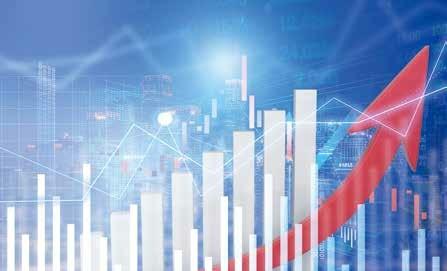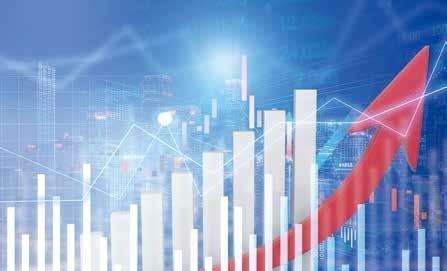Global Growth—An Uneven Race
2021-11-26ByRaziaKhan,EdwardLee
By Razia Khan,Edward Lee

Multi-speed economic recovery, with risks
The scale of U.S. fiscal stimulus and the speed of vaccine rollout have significantly lifted global economic prospects. We raise our 2021 global growth forecast to 5.7% from 4.8%. Growth optimism has driven markets since we made our initial forecast in December of 2020, contributing to commodity gains and new inflation concerns. However, we maintain a cautious outlook given the uneven nature of the economic recovery.
The speed of vaccine rollout is a key differentiator of near-term growth prospects, and U.S. growth now looks likely to be front-loaded. Around 30% of the U.S. population had received at least one Covid-19 vaccine dose by the end of March, enabling a faster and likely more sustained economic recovery. In Europe, vaccine supply bottlenecks and the slower pace of progress have prompted us to lower our 2021 GDP forecast. Downside risks to growth persist given new waves of COVID and the likelihood that containment measures will need to be extended. Europes fiscal response to the pandemic has been more constrained when compared to the U.S.; slow progress on submitting reform plans is likely to delay disbursements from the EUs Recovery Fund.
China is likely to maintain robust growth this year, with the authorities tapering stimulus only moderately in order to safeguard economic recovery. The Peoples Bank of China (PBoC) has pledged to stabilize the macro leverage ratio by making credit growth more consistent with nominal GDP growth. Rebalancing will become more important, as growth to date has been insufficiently broad-based and concentrated in exports (where demand is largely COVID-related, for example PPE or electronics) or sectors benefiting from easy credit. Consumer-related sectors such as catering, accommodation, tourism and air travel remain well below pre-pandemic levels.
The acceleration of industrial production growth has highlighted supply bottlenecks and the risk of rising producer inflation. Chinas latest 14th Five-Year Plan aims to prioritize high-quality growth by deepening supply-side reforms, expanding domestic demand and fostering homegrown innovation.
In India, more expansionary fiscal policy should support recovery momentum. We expect a sharp recovery to double-digit growth in FY22 (ending March 2022), driven by consumption and public capital expenditure. Indias economic recovery has been uneven to date, with the informal sector lagging the formal sector and rural demand growing faster than urban demand. Policy – especially monetary policy – will need to remain supportive to sustain the recovery. Higher oil prices pose a risk, as do obstacles to vaccinating Indias large population, and localized COVID outbreaks are a concern. Case numbers have recently surged to their highest since October 2020. We do not expect the majority of the population to be vaccinated until 2022, suggesting that economic activity remains vulnerable to restrictions during episodes of higher infections.

The pace of recovery also diverges across the rest of Asia. Developing domestic pandem-ic situations are a key driver of this divergence. Taiwan and Vietnam are among the few economies that started 2021 with GDP above preCOVID levels. Strong external demand and successful domestic pandemic management support the positive growth outlook for these economies. In contrast, an early-year surge in infections in Indonesia and Malaysia has negatively affected their 2021 outlook (we downgraded our growth forecasts for these economies earlier this year). The situation has since stabilized, but not without affecting their growth recoveries. Similarly, we have downgraded our 2021 GDP growth forecast for Japan, partly due to the six-week emergency lockdown in January-February.
In domestically driven economies such as Indonesia and the Philippines, the pace of vaccine rollout will be particularly important to the resumption of activity. In the Philippines, household consumption accounts for approximately 72% of GDP and contracted 7.9% in 2020. The economy is now seeing a resurgence of infections to the highest levels since the start of the pandemic; this looks set to delay the reopening of the economy. Excluding Singapore, many Asian economies have vaccine rollout rates below the global average. Singapore and Malaysia are targeting herd immunity by yearend; more populous Vietnam and Thailand target inoculating 25% and 50% of their populations, respectively, by the end of 2021.
Middle Eastern economies such as the UAE, Bahrain and Qatar have seen some of the fastest vaccine rollout rates; the UAE leads GCC economies, at 79.1 vaccinations administered per 100 people as of endMarch. However, progress has been uneven across the region – the comparable numbers are 11.1 for Saudi Arabia, 8.6 for Kuwait and 2.6 for Oman, suggesting a staggered recovery even as economies reopen.
We forecast a gradual postCOVID growth recovery for the MENAP region this year given the dual pressures of lower oil prices and output. Despite higher oil prices, Saudi Arabias unilateral production cuts weigh on its H1 growth outlook, given the sensitivity of real growth to output levels.
Growth positives for the region include the resolution of the Gulf diplomatic dispute with Qatar, which will ease bottlenecks and should boost intra-regional trade and travel over time; and Dubais hosting of EXPO 2020 (delayed by a year to October 2021), which should boost tourism. Nonetheless, structural concerns persist. Longterm scarring from the COVID crisis has yet to manifest fully. Smaller Gulf states have seen population declines as large numbers of expatriates have departed. While the UAE has introduced visa and social liberalization reforms to facilitate tourism and attract new remote-working residents, region-wide expatriate population declines may weigh on the consumption recovery. Fiscal reforms necessitated by recent economic pressures, including Saudi Arabias tripling of VAT and Omans planned VAT introduction in Q2-2021, may also weigh on consumption.
Sub-Saharan Africa (SSA) is likely to see only a technical recovery in 2021, driven by a weaker base from 2020. Logistical hurdles and affordability issues have precluded faster vaccine rollout. As of early March, the SSA region accounted for only circa 0.04% of COVID vaccines administered globally. A full SSA economic recovery could be delayed by rising vaccine nationalism in more developed markets and the prioritization of domestic needs amid new COVID waves in Europe and India. SSA is the region most dependent on the World Health Organization-funded COVAX scheme for its vaccine supply. SSA faces the threat of a third COVID wave; in March, Kenya became the regions latest major economy to announce new containment measures.
The news is not all negative, however. The regions largest economies, South Africa and Nigeria, both saw positive Q4-2020 growth surprises. Rising commodity prices, especially oil, could provide fiscal revenue relief in producing countries. South Africa saw positive revenue momentum in FY21 (ends March 2021), partly due to higher corporate tax revenue from the mining sector. SSA commodity producers may also start to benefit from the longer-term push by large EM economies such as China and India to further diversify their oil sources. However, the regions non-commodity-producing, oil-importing economies face more significant growth headwinds.
The Biden administrations embrace of multilateralism should also favor SSA economies, most meaningfully through new G7 approval of increased IMF SDR allocations. The expected new SDR allocation to all IMF member countries should provide a much-needed boost to regional economies FX reserves. Significant COVID-related revenue deterioration has left many SSA economies with elevated debt ratios. Given their existing vulnerabilities, they may stand to benefit the most from the across-the-board boost to external liquidity provided by an SDR re-allocation. The benefit would be even more pronounced if low-income countries see a further reallocation of existing SDRs from economies that do not need higher allocations.
Risks to the recovery – Is the inflation threat real?
From “reflation” to inflation—Inflation is again occupying the markets attention as the global economy returns to growth. The market focus has recently shifted from economic recovery (the “reflation trade”) to fears of higher inflation. Accommodative policy globally, low base effects from last year, record US fiscal stimulus, and higher commodity prices have driven these concerns.
We think inflation concerns are largely overdone. Supply-chain disruptions during the pandemic had led to higher prices in some instances, fuelling inflation fears. The recent temporary closure of the Suez Canal and rising freight rates have reinforced expectations of a shift away from ‘just-in-time supply chains, which played a key role in the global disinflation trend of the last two decades. However, it seems premature to predict the end of globalisation-driven disinflation. While a focus on domestic self-sufficiency has led to a shift towards “just-incase” supply chains in some cases (for example, semiconductor production in the U.S.), production efficiency will remain the overriding driver of sourcing decisions, in our view.
Economic reopening is likely to lead to one-off price pressures, but secondary price effects are unlikely. Prolonged lockdowns across both developed and emerging economies have led to a rise in ‘unintended savings, swelling retail bank balances. As restrictions are eased and economies reopen following the shutdown of services sectors, mini-consumption booms are anticipated. Pent-up demand may pressure prices. Could this turn into more significant inflationary pressure? Given persistently large negative output gaps, and with a return to full employment some years away, we do not think so. Central bankers have emphasized that they will look through transient price shocks.
A number of factors support our view that market fears of higher global inflation are overblown.
The view from the U.S.—We have an above-consensus view on core PCE, expecting it to rise to 2.5% in Q2-2021 due to a pronounced base effect, higher non-energy import prices, and a robust acceleration in consumer spending as the economy reopens. Supply bottlenecks could also add to near-term price pressures. However, given that full employment is not expected until 2023, we think price pressures are unlikely to remain elevated. Further fiscal stimulus will focus on infrastructure, which should ease supply constraints over the long term. Investment in infrastructure would be considered less inflationary than putting stimulus checks directly in the hands of consumers. Fed Chair Powell has emphasized that the U.S. has been “living in a disinflationary world for a long time”. In the Feds view, a one-time shock will not change this.
The view from Europe—We expect inflation to pick up sharply in the coming months on higher energy prices, pandemic-related supply constraints and stronger demand. Inflation may even reach 2% later in 2021. But given low wage pressures and significant economic slack, we expect price pressures to fade thereafter; higher inflation is likely to be only temporary.
The view from China—Chinas industrial sector risks overheating; its pace of y/y growth in January-February 2021 (from a weak 2020 base) exceeded the average for the same period in 2015-19. Supply constraints and recovering commodity prices could drive PPI inflation even higher. We expect Chinas PPI, which is traditionally more strongly correlated with US CPI, to exceed 5% y/y in Q3-2021. That said, the lack of significant momentum in Chinas consumer sector to date may limit CPI gains. Given anecdotal evidence of a turnaround in the consumer sector, we will be watching CPI inflation risks closely.
The view from other Asian economies—Since the start of 2021, economies such as Malaysia, Singapore, Korea and the Philippines have already seen higher inflation prints. Excepting the Philippines, price pressure remains benign, in our view.
Price increases have been limited, with only a small subset of inflation basket components showing price increases higher than their 2015-2019 averages. Price levels are within central banks tolerance ranges, and core inflation is low. The overall price environment remains unthreatening and should allow Asian central banks to maintain their accommodative policy stance.
The view from commodity markets—Copper has rallied strongly, with prices reaching the highest levels since 2011. Vaccine optimism, expectations of a greener post-COVID economic reopening, and firm renewables demand have all played a role. In the case of oil, which has been vulnerable to news of vaccine supply bottlenecks, unilateral Saudi production cuts have also supported prices. We think Saudi Arabia is unlikely to favour increased production until the improvement in oil demand is confirmed. This may materialise only in Q3-2021, leaving room for oil price upside in the interim. We see a high risk of an oil price overshoot in Q2-2021, with prices potentially averaging USD 73/bbl. Eventually however, the supply response is likely to guide prices lower in late 2021 and 2022. The inflation threat from oil is unlikely to be sustained.
杂志排行
China’s foreign Trade的其它文章
- The Automobile Consumption Market Welcomes Consumers of Younger Generations
- A Huge Party for the Youth
- Carbon Pricing Requires More International Cooperation and Dialogue
- The Digital Transformation Produces Higher Demand for Technology Talent
- The Segment Pet Markets Become Increasingly Popular
- “Invest Liaoning”Platform Promotes Integrated Development of Liaoning’s Open Economy
